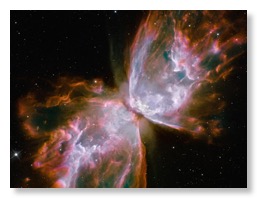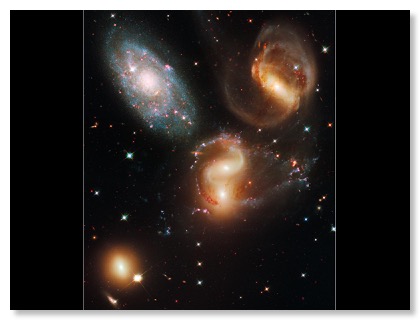NASA Shows off new Hubble Photos
09/09/09 12:00 Filed in: NASA
Astronomers declared NASA's Hubble Space Telescope a fully rejuvenated observatory with the release Wednesday of observations from four of its six operating science instruments. The new pictures that have been released are truly amazing. The hubble continues to give us a closer visual insight into the “glory of God” in the heavens.
The following text comes from the NASA.gov website:

Click to ZoomNGC 6302 - Butterfly Emerges from Stellar Demise in Planetary Nebula NGC 6302
This celestial object looks like a delicate butterfly. But it is far from serene. What resemble dainty butterfly wings are actually roiling cauldrons of gas heated to more than 36,000 degrees Fahrenheit. The gas is tearing across space at more than 600,000 miles an hour -- fast enough to travel from Earth to the moon in 24 minutes!
A dying star that was once about five times the mass of the Sun is at the center of this fury. It has ejected its envelope of gases and is now unleashing a stream of ultraviolet radiation that is making the cast-off material glow. This object is an example of a planetary nebula, so-named because many of them have a round appearance resembling that of a planet when viewed through a small telescope.
The Wide Field Camera 3 (WFC3), a new camera aboard NASA’s Hubble Space Telescope, snapped this image of the planetary nebula, catalogued as NGC 6302, but more popularly called the Bug Nebula or the Butterfly Nebula. WFC3 was installed by NASA astronauts in May 2009, during the servicing mission to upgrade and repair the 19-year-old Hubble telescope.
NGC 6302 lies within our Milky Way galaxy, roughly 3,800 light-years away in the constellation Scorpius. The glowing gas is the star’s outer layers, expelled over about 2,200 years. The "butterfly" stretches for more than two light-years, which is about half the distance from the Sun to the nearest star, Alpha Centauri.
The central star itself cannot be seen, because it is hidden within a doughnut-shaped ring of dust, which appears as a dark band pinching the nebula in the center. The thick dust belt constricts the star’s outflow, creating the classic "bipolar" or hourglass shape displayed by some planetary nebulae.

Click to ZoomGalactic Wreckage in Stephan’s Quintet
A clash among members of a famous galaxy quintet reveals an assortment of stars across a wide color range, from young, blue stars to aging, red stars.
This portrait of Stephan’s Quintet, also known as Hickson Compact Group 92, was taken by the new Wide Field Camera 3 (WFC3) aboard NASA’s Hubble Space Telescope. Stephan’s Quintet, as the name implies, is a group of five galaxies. The name, however, is a bit of a misnomer. Studies have shown that group member NGC 7320, at upper left, is actually a foreground galaxy about seven times closer to Earth than the rest of the group.
Three of the galaxies have distorted shapes, elongated spiral arms, and long, gaseous tidal tails containing myriad star clusters, proof of their close encounters. These interactions have sparked a frenzy of star birth in the central pair of galaxies. This drama is being played out against a rich backdrop of faraway galaxies.
The image, taken in visible and infrared light, showcases WFC3’s broad wavelength range. The colors trace the ages of the stellar populations, showing that star birth occurred at different epochs, stretching over hundreds of millions of years. The camera’s infrared vision also peers through curtains of dust to see groupings of stars that cannot be seen in visible light.

Click to ZoomColorful Stars Galore Inside Globular Star Cluster Omega Centauri
NASA's Hubble Space Telescope snapped this panoramic view of a colorful assortment of 100,000 stars residing in the crowded core of a giant star cluster.
The image reveals a small region inside the massive globular cluster Omega Centauri, which boasts nearly 10 million stars. Globular clusters, ancient swarms of stars united by gravity, are the homesteaders of our Milky Way galaxy. The stars in Omega Centauri are between 10 billion and 12 billion years old. The cluster lies about 16,000 light-years from Earth.
This is one of the first images taken by the new Wide Field Camera 3 (WFC3), installed aboard Hubble in May 2009, during Servicing Mission 4. The camera can snap sharp images over a broad range of wavelengths.
The photograph showcases the camera's color versatility by revealing a variety of stars in key stages of their life cycles.
The majority of the stars in the image are yellow-white, like our Sun. These are adult stars that are shining by hydrogen fusion. Toward the end of their normal lives, the stars become cooler and larger. These late-life stars are the orange dots in the image.
All of the stars in the image are cozy neighbors. The average distance between any two stars in the cluster's crowded core is only about a third of a light-year, roughly 13 times closer than our Sun's nearest stellar neighbor, Alpha Centauri. Although the stars are close together, WFC3's sharpness can resolve each of them as individual stars. If anyone lived in this globular cluster, they would behold a star-saturated sky that is roughly 100 times brighter than Earth's sky.
Hubble observed Omega Centauri on July 15, 2009, in ultraviolet and visible light. These Hubble observations of Omega Centauri are part of the Hubble Servicing Mission 4 Early Release Observations.
The following text comes from the NASA.gov website:

Click to Zoom
This celestial object looks like a delicate butterfly. But it is far from serene. What resemble dainty butterfly wings are actually roiling cauldrons of gas heated to more than 36,000 degrees Fahrenheit. The gas is tearing across space at more than 600,000 miles an hour -- fast enough to travel from Earth to the moon in 24 minutes!
A dying star that was once about five times the mass of the Sun is at the center of this fury. It has ejected its envelope of gases and is now unleashing a stream of ultraviolet radiation that is making the cast-off material glow. This object is an example of a planetary nebula, so-named because many of them have a round appearance resembling that of a planet when viewed through a small telescope.
The Wide Field Camera 3 (WFC3), a new camera aboard NASA’s Hubble Space Telescope, snapped this image of the planetary nebula, catalogued as NGC 6302, but more popularly called the Bug Nebula or the Butterfly Nebula. WFC3 was installed by NASA astronauts in May 2009, during the servicing mission to upgrade and repair the 19-year-old Hubble telescope.
NGC 6302 lies within our Milky Way galaxy, roughly 3,800 light-years away in the constellation Scorpius. The glowing gas is the star’s outer layers, expelled over about 2,200 years. The "butterfly" stretches for more than two light-years, which is about half the distance from the Sun to the nearest star, Alpha Centauri.
The central star itself cannot be seen, because it is hidden within a doughnut-shaped ring of dust, which appears as a dark band pinching the nebula in the center. The thick dust belt constricts the star’s outflow, creating the classic "bipolar" or hourglass shape displayed by some planetary nebulae.

Click to Zoom
A clash among members of a famous galaxy quintet reveals an assortment of stars across a wide color range, from young, blue stars to aging, red stars.
This portrait of Stephan’s Quintet, also known as Hickson Compact Group 92, was taken by the new Wide Field Camera 3 (WFC3) aboard NASA’s Hubble Space Telescope. Stephan’s Quintet, as the name implies, is a group of five galaxies. The name, however, is a bit of a misnomer. Studies have shown that group member NGC 7320, at upper left, is actually a foreground galaxy about seven times closer to Earth than the rest of the group.
Three of the galaxies have distorted shapes, elongated spiral arms, and long, gaseous tidal tails containing myriad star clusters, proof of their close encounters. These interactions have sparked a frenzy of star birth in the central pair of galaxies. This drama is being played out against a rich backdrop of faraway galaxies.
The image, taken in visible and infrared light, showcases WFC3’s broad wavelength range. The colors trace the ages of the stellar populations, showing that star birth occurred at different epochs, stretching over hundreds of millions of years. The camera’s infrared vision also peers through curtains of dust to see groupings of stars that cannot be seen in visible light.

Click to Zoom
NASA's Hubble Space Telescope snapped this panoramic view of a colorful assortment of 100,000 stars residing in the crowded core of a giant star cluster.
The image reveals a small region inside the massive globular cluster Omega Centauri, which boasts nearly 10 million stars. Globular clusters, ancient swarms of stars united by gravity, are the homesteaders of our Milky Way galaxy. The stars in Omega Centauri are between 10 billion and 12 billion years old. The cluster lies about 16,000 light-years from Earth.
This is one of the first images taken by the new Wide Field Camera 3 (WFC3), installed aboard Hubble in May 2009, during Servicing Mission 4. The camera can snap sharp images over a broad range of wavelengths.
The photograph showcases the camera's color versatility by revealing a variety of stars in key stages of their life cycles.
The majority of the stars in the image are yellow-white, like our Sun. These are adult stars that are shining by hydrogen fusion. Toward the end of their normal lives, the stars become cooler and larger. These late-life stars are the orange dots in the image.
All of the stars in the image are cozy neighbors. The average distance between any two stars in the cluster's crowded core is only about a third of a light-year, roughly 13 times closer than our Sun's nearest stellar neighbor, Alpha Centauri. Although the stars are close together, WFC3's sharpness can resolve each of them as individual stars. If anyone lived in this globular cluster, they would behold a star-saturated sky that is roughly 100 times brighter than Earth's sky.
Hubble observed Omega Centauri on July 15, 2009, in ultraviolet and visible light. These Hubble observations of Omega Centauri are part of the Hubble Servicing Mission 4 Early Release Observations.
blog comments powered by Disqus